
BM-003
Trang 1 / 14
TRƯỜNG ĐẠI HỌC VĂN LANG
ĐƠN VỊ: KHOA NGOẠI NGỮ
ĐỀ THI VÀ ĐÁP ÁN
THI KẾT THÚC HỌC PHẦN
Học kỳ 2, năm học 2023-2024
I. Thông tin chung
Tên học phần:
Đọc 2
Mã học phần:
71ENGL30382
Số tín chỉ:
2
Mã nhóm lớp học phần:
232_71ENGL30382_05,06
Hình thức thi: Trắc nghiệm kết hợp Tự luận
Thời gian làm bài:
60
phút
Thí sinh được tham khảo tài liệu:
☐ Có
☒ Không
1. Format đề thi
- Font: Times New Roman
- Size: 13
- Tên các phương án lựa chọn: in hoa, in đậm
- Không sử dụng nhảy chữ/số tự động (numbering)
- Mặc định phương án đúng luôn luôn là Phương án A ghi ANSWER: A
- Tổng số câu hỏi thi:
- Quy ước đặt tên file đề thi:
+ Mã học phần_Tên học phần_Mã nhóm học phần_TNTL_De 1
+ Mã học phần_Tên học phần_Mã nhóm học phần_TNTL_De 1_Mã đề (Nếu sử dụng
nhiều mã đề cho 1 lần thi).
2. Giao nhận đề thi
Sau khi kiểm duyệt đề thi, đáp án/rubric. Trưởng Khoa/Bộ môn gửi đề thi, đáp án/rubric
về Trung tâm Khảo thí qua email: khaothivanlang@gmail.com bao gồm file word và file pdf
(nén lại và đặt mật khẩu file nén) và nhắn tin + họ tên người gửi qua số điện thoại
0918.01.03.09 (Phan Nhất Linh).
- Khuyến khích Giảng viên biên soạn và nộp đề thi, đáp án bằng File Hot Potatoes. Trung
tâm Khảo thí gửi kèm File cài đặt và File hướng dẫn sử dụng để hỗ trợ Quý Thầy Cô.

BM-003
Trang 2 / 14
II. Các yêu cầu của đề thi nhằm đáp ứng CLO
(Phần này phải phối hợp với thông tin từ đề cương chi tiết của học phần)
Ký hiệu
CLO
Nội dung CLO
Hình thức
đánh giá
Trọng số
CLO trong
thành phần
đánh giá
(%)
Câu hỏi
thi số
Điểm số
tối đa
Lấ,y dữ liệu
đo lường mức
đạt PLO/PI
(1)
(2)
(3)
(4)
(5)
(6)
(7)
CLO1
Áp dụng từ vựng
đã học để đọc
hiểu các bài đọc
học thuật từ 300
đến 500 từ
Tự luận
+ Trắc
nghiệm
20%
- Từ
câu 20
đến câu
21 (trắc
nghiệm)
- Từ câu
6 đến
câu 13
(tự luận)
0,5đ
2đ
CLO2
Vận dụng quy
trình đọc hiểu
vào các bài đọc
học thuật từ 300
đến 500 từ
Tự luận
+ Trắc
nghiệm
30%
Từ câu
1 đến
13
4đ
CLO3
Thực hiện được
việc đọc lướt lấy
ý chính và đọc
hiểu chi tiết các
bài đọc học thuật
từ 300 đến 500
từ 300 đến 500
từ
Tự luận
+ Trắc
nghiệm
50%
- Từ
câu 14
đến 19
(trắc
nghiệm)
- Từ
câu 1
đến câu
5 (tự
luận)
1,5đ
2đ
Chú thích các cột:
(1) Chỉ liệt kê các CLO được đánh giá bởi đề thi kết thúc học phần (tương ứng như đã mô tả trong
đề cương chi tiết học phần). Lưu ý không đưa vào bảng này các CLO không dùng bài thi kết thúc học
phần để đánh giá (có một số CLO được bố trí đánh giá bằng bài kiểm tra giữa kỳ, đánh giá qua dự
án, đồ án trong quá trình học hay các hình thức đánh giá quá trình khác chứ không bố trí đánh giá
bằng bài thi kết thúc học phần). Trường hợp một số CLO vừa được bố trí đánh giá quá trình hay giữa
kỳ vừa được bố trí đánh giá kết thúc học phần thì vẫn đưa vào cột (1)
(2) Nêu nội dung của CLO tương ứng.
(3) Hình thức kiểm tra đánh giá có thể là: trắc nghiệm, tự luận, dự án, đồ án, vấn đáp, thực hành
trên máy tính, thực hành phòng thí nghiệm, báo cáo, thuyết trình,…, phù hợp với nội dung của CLO
và mô tả trong đề cương chi tiết học phần.
(4) Trọng số mức độ quan trọng của từng CLO trong đề thi kết thúc học phần do giảng viên ra đề
thi quy định (mang tính tương đối) trên cơ sở mức độ quan trọng của từng CLO. Đây là cơ sở để
phân phối tỷ lệ % số điểm tối đa cho các câu hỏi thi dùng để đánh giá các CLO tương ứng, bảo đảm

BM-003
Trang 3 / 14
CLO quan trọng hơn thì được đánh giá với điểm số tối đa lớn hơn. Cột (4) dùng để hỗ trợ cho cột
(6).
(5) Liệt kê các câu hỏi thi số (câu hỏi số … hoặc từ câu hỏi số… đến câu hỏi số…) dùng để kiểm
tra người học đạt các CLO tương ứng.
(6) Ghi điểm số tối đa cho mỗi câu hỏi hoặc phần thi.
(7) Trong trường hợp đây là học phần cốt lõi - sử dụng kết quả đánh giá CLO của hàng tương ứng
trong bảng để đo lường đánh giá mức độ người học đạt được PLO/PI - cần liệt kê ký hiệu PLO/PI có
liên quan vào hàng tương ứng. Trong đề cương chi tiết học phần cũng cần mô tả rõ CLO tương ứng
của học phần này sẽ được sử dụng làm dữ liệu để đo lường đánh giá các PLO/PI. Trường hợp học
phần không có CLO nào phục vụ việc đo lường đánh giá mức đạt PLO/PI thì để trống cột này.
III. Nội dung câu hỏi thi
PHẦN TRẮC NGHIỆM (21 câu + 0,4đ/ câu – Phần I; 0,25đ/ câu – Phần II & III)
Part I: Read the passage below and match the headings with the correct paragraphs (2
marks)
(A) Here is what global warming could do in a few years: in Dallas, a doubled level of
carbon dioxide would increase the number of days a year with temperatures above 100
degrees from nineteen to seventy-eight. On sixty-eight days, as opposed to the current four,
the temperature wouldn’t fall below 80 degrees at night. One hundred and sixty-two days a
year, the temperature would top 90 degrees.
(B) Although most scientists agree that increasing levels of carbon dioxide and other
greenhouse gases will inevitably lead to global warming, no one is certain how fast and how
much temperatures will rise and what the effects will be in any geographical areas. This gives
policymakers an excuse for delaying action. Some experts predict that within two centuries
glaciers in the North and South Poles will melt, ocean levels will rise, and much of what is
now the coast of the United States will be under water. They also predict great droughts and
hurricanes, as a result of climate changes.
(C) Other scientists think the changes will be much more gradual, even beneficial. After
all, Canada would not complain if the productive corn-growing lands – now located in the
U.S. Midwest – were shifted north across the border.
(D) While many nations could end up with milder climates, the change – perhaps 100 times
faster than at any time in human history – could be so drastic that many of the benefits would
be lost. There could be crowds of environmental refugees, as well, making the tragedy of the
Dust Bowl era seem mild in comparison.
(E) What can we do? People's contributions to the greenhouse effect come from so many
basic activities that we can’t hope to eliminate it completely. Some steps have already been

BM-003
Trang 4 / 14
taken. Since the 1970s, the use of CFCs as aerosol-can propellants has been banned in the
United States.
(F) Another strategy is to burn as much methane as possible. This adds CO₂ to the air, but
since methane traps twenty times as much heat as CO₂, the net result is worthwhile. The gas
in many garbage landfills is already being used in a number of places around the United States.
It is being used to heat thousands of homes.
Paragraph A _____
A. Global warming in the future
B. The potential loss
C. Burning more methane
D. A ban on propellant
E. Uncertain future of rising global temperature
ANSWER: A
Paragraph B _____
A. Uncertain future of rising global temperature
B. The potential loss
C. Burning more methane
D. A ban on propellant
E. Global warming in the future
ANSWER: A
Paragraph D _____
A. The potential loss
B. Uncertain future of rising global temperature
C. Burning more methane
D. A ban on propellant
E. Global warming in the future
ANSWER: A
Paragraph E_____

BM-003
Trang 5 / 14
A. A ban on propellant
B. Uncertain future of rising global temperature
C. Burning more methane
D. The potential loss
E. Global warming in the future
ANSWER: A
Paragraph F_____
A. Burning more methane
B. Uncertain future of rising global temperature
C. The potential loss
D. A ban on propellant
E. Global warming in the future
ANSWER: A
Part II: Read the text below and decide if the statements are True, False, or Not Given.
(2 marks)
TRUE – if the statement agrees with the text
FALSE – if the statement disagrees with the text
NOT GIVEN – if there is no information on this
1 Laws that ban smoking in public places are not exactly a new idea. One of the world’s
first smoking bans was introduced in 1575, when the Roman Catholic Church passed a law
that made it illegal to smoke in any church in the Spanish colonies of Central America. In the
eighteenth century, a number of German and Austrian cities also banned smoking, not in
specific locations or buildings, but anywhere in the city. Some of these bans were based on
ideas about health. Others were more concerned with safety. The Old Government Building
in Wellington, New Zealand banned smoking in the 19th century because the building was
made entirely of wood; smoking was a fire risk.
2 In the second half of the twentieth century, campaigns began to make people aware of
the health dangers of smoking, and the concept of passive smoking – or breathing other
people’s smoke – became a widespread concern. As a result, governments passed laws in the
1970s to control the use of tobacco, and restaurants and other public places began to create







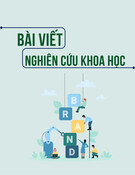
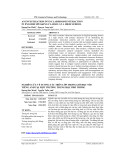
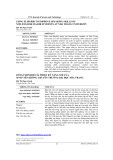
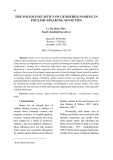
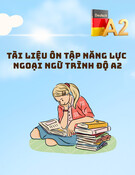




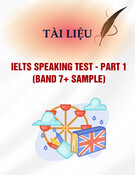

![Mẫu thư Tiếng Anh: Tài liệu [Mô tả chi tiết hơn về loại tài liệu hoặc mục đích sử dụng]](https://cdn.tailieu.vn/images/document/thumbnail/2025/20250814/vinhsannguyenphuc@gmail.com/135x160/71321755225259.jpg)







